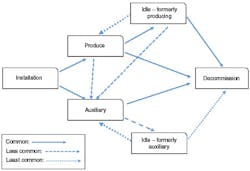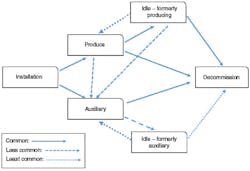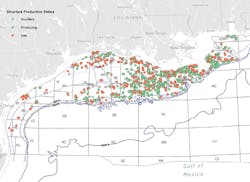Review of shallow-water structures highlights classification challenges
Mark J Kaiser
Siddhartha Narra
Center for Energy Studies
Louisiana State University
There are many ways to classify offshore structures and the most common categories involve production status, function, structure, and product type. In the third part of this review of Gulf of Mexico (GoM) shallow-water structures, classifications are introduced and discussed. In the next three parts of the series, the authors will describe each structure category in detail.
Production status is the most obvious classification since a structure is either currently producing or not producing (idle) or has never produced (auxiliary). Complications arise because some structures transition between classes during their lifetime, such as formerly producing structures that now serve an alternative role as a transport platform or service platform.
Producing structures
Structures where wells first board and that have produced during the last year are classified as producing. Producing structures include minor structures such as caissons and well protectors as well as major fixed platforms. Fixed platforms with less than six pieces of equipment are considered minor and are functionally equivalent to caissons/well protectors since they do not provide full processing capacity. Almost all caissons and well protectors deliver their production to another facility (i.e., a major platform) for processing before it is exported to shore.
There are many reasons why a structure may stop producing, including: reserves depletion, uneconomic production, well failure, scheduled workovers, weather damage, fire, third-party problems (i.e., pipelines), recompletion, investment review, etc. Production cessation may be short or long term.
Structure classifications and transition pathways.
Producing platforms may be repurposed to serve an auxiliary role if they are well positioned and the operator can use the structure in a useful purpose. The ‘long-term’ cessation of production without serving a useful purpose classifies a structure as idle.
Auxiliary structures
Auxiliary structures are used in support of operations but do not have any wells – or no longer have any wells – that directly board the structure. On auxiliary structures no trees or conductors or well slots will be found. Auxiliary structures are installed new or may be converted from formerly producing structures.
Auxiliary platforms have been used for many years for processing and export operations, to expand capacity at existing structures, for pumping or compressor stations, storage, quarters, pipeline junctions and meters. Sometimes small platforms are built adjacent to larger platforms to increase available space or to permit carrying heavier equipment loads on the principal platform.
During the early years of offshore development, it was common to separate drilling operations from production and quarters and so many auxiliary structures are found within a complex of connected structures. In later decades, as improved technology and construction capability allowed multiple functions to be combined, there was less need for auxiliary structures and smaller numbers were installed.
Auxiliary structures are primarily a shallow water phenomenon and since they are not directly associated with wells most are four-pile or larger platforms. Caissons are not a common structure type for auxiliary platforms.
One way to transform a formerly producing structure into an auxiliary structure is to plug and abandon all the wellbores and to run production from another field/platform across the facility. Another way for an idle structure to transform into an auxiliary structure is to recertify the structure as a transportation pipeline or fuel depot hub.
Recent installations of auxiliary structures have been in support of transportation companies to provide pumping and compression pressure for pipelines, to serve as a pig receiver and delivery station, slug catcher, etc. to link deepwater production to shelf infrastructure.
Idle–formerly producing
A third class of structure that is important to distinguish are formerly producing structures that have not produced for one year or more, often referred to as ‘idle iron’ or ‘idle–formerly producing.’
Producing, idle, and auxiliary structures in shallow water. Source: Data from BOEM, February 2018.
Idle structures are a natural feature of offshore development and collect as part of the active inventory until decommissioned. Some idle structures may currently be serving a useful purpose and others may return to production and still others may be repurposed for another function. However, the number of structures that make these transitions are relatively few because several conditions must be satisfied to successfully make the transition.
An idle structure may return to production if any of its inactive or unplugged wells are brought back online, say through a side track operation or recompletion, or if a new well is successful. However, the longer a structure is idle the less likely is this outcome. Capital spending on re-drilling operations are risky and although expenditures are not large relative to new wellbores, the uncertainty is high which constrains activity.
All idle structures previously produced hydrocarbons but at the time of evaluation the structure did not produce during the previous year. The reason for the cessation of production is not publicly reported and the utility of the structure is not observable which restricts our ability to draw detailed conclusions about subclasses of idle structures.
In some cases, operatorship and a review of active pipelines crossing the structure can provide a clue to a structure’s function (e.g., if the operator is a gas transmission company the structure has likely been repurposed) but the inference is subject to uncertainty and only applies for a subclass of structure.
Idle – formerly auxiliary
There is a fourth structure class involving auxiliary structures that no longer serve a useful function, labeled ‘auxiliary – no longer useful’ or ‘idle – formerly auxiliary’ to distinguish from the ‘idle – formerly producing’ subgroup.
Again, identifying the utility of auxiliary structures that are no longer useful is not possible using public databases. This structure class may be void (i.e., empty) but it is likely to contain at least some structures.
Oil vs. gas structures
Most wells produce both oil and gas, but there is often a dominant stream which identifies the well as primarily ‘oil’ or ‘gas’ producing. Since structures serve as the aggregation point for well production from one or more reservoirs and fields, there are normally a mix of ‘oil’ and ‘gas’ wells associated with a structure.
Structures are classified as ‘primarily oil’ (or ‘oil’) or ‘primarily gas’ (or ‘gas’) based on their cumulative gas oil ratio (CGOR), defined as total gas production measured in cubic feet (cf) to oil production measured in barrels (bbl).
Typically, a CGOR threshold greater than 10,000 cf/bbl is used to classify a well as ‘primarily gas’ while CGOR less than 10,000 cf/bbl identifies a ‘primarily oil’ well. There is no universally agreed-upon value of the threshold, however, and cutoffs smaller than 5,000 cf/bbl or values greater than 10,000 cf/bbl may be employed. Lowering the threshold will reduce the oil structure count and increase the gas structure, and vice versa.


